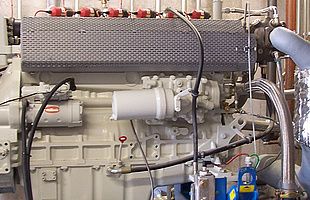A renowned plant manufacturer, who builds turnkey CHP plants for its customers worldwide, needed a new engine control system due to new international standards regarding the use of renewable energy sources and the associated technical requirements.
The challenge
- Controlling a wide range of engines between 75 kW and 750 kW from different manufacturers (DEUTZ, MAN, etc.) using the same control system.
- Controlling and regulating the entire CHP range
- Aligning the system for different types of gas: natural gas, biogas, wood gas
- Meeting grid connection requirements in accordance with VDE-AR-N 4110 and 4105
- Reducing total costs, including follow-up maintenance and service costs
- Adapting our openECS control system to customer-specific requirements within four months
With our E²CON-CHP system, we were able to fulfil the customer's wish of using only one controller to manage all engines and plants, regardless of manufacturer and power class, from its product portfolio and the entire CHP range.
This greatly simplifies future commissioning and subsequent service and system maintenance. We were also able to effectively align the system to different types of gas, such as natural gas, biogas or wood gas.
Our solution
On the basis of our highly-flexible modular system, we implemented a solution for the customer that allows them to improve the connection of new components by themselves if so desired.
A broad range of sensors and sensor types can be integrated into our E²CON-CHP solution, which we developed in consideration of customer-internal standardization. Common sensors for pressure and temperature are part of the standard package, and the level of scaling can be defined individually.
The I/Os are logically divided into two cabinets, one close to the engine and one close to the circuit breaker. This enables short sensor cable lengths, which increase system reliability and accuracy.
The system is also able to operate in grid-parallel or stand-alone mode. Hence it does not depend on the grid feed. This means the engines can be started even during a power failure. A synchronization unit and network and generator protection functions are included.
A further advantage: The controller has already been certified according to VDE-AR-N 4110, which is the German implementation of the European directive on regulating all voltage levels. To achieve certification, the system does not use an error-prone UPS (uninterrupted power supply) but instead bridges critical voltage states via reliable 24 V batteries.
In the E²CON-CHP of the customer, the following is used:
- E²CORE-control: highly-dynamic, multi-variable controller for simultaneous control of speed, power and mixture.
- E²KNOCKCON-c: for reliable cylinder-specific knock and misfire detection
- E²PILOT: operating terminal with 15" capacitive touch screen, customized for the system operator.
- E²SERVICE: our service visualization tool for optimal parameterization and system diagnosis with interactive operating log and configurable trends
- AVAT VIRTUAL SERVICES: for remote access, fleet management and predictive maintenance
- NOx regulation: in accordance with the 44th BImSchV (Ordinance for the Implementation of the Federal Immission Control Act )
- Unit certificate: in accordance with VDE-AR-N 4110
- Interfaces: for connecting to direct marketers or grid operators
Customer benefits
Our customer will be able to offer their own demanding customers a premium-quality, AVAT E²CON-CHP-based engine and CHP control system that can be adapted to new market demands at any time and is therefore well prepared for the rapid market trends in the energy sector in the coming years.
Thanks to the E²CON-CHP, our control system for engines and entire CHP plants, and our extensive expertise, we were able to meet the high customer requirements in a short time and help them achieve series production.
The prototype entered operation on schedule 4 months after the order was placed, which meant that compliance with the VDE-AR-N 4110 and 4105 grid connection requirements could be certified on time.
Success factors at a glance
- tight schedule from the first coordination meeting to the test run of a prototype system
- professional requirements analysis and consulting
- close coordination of engineering tasks throughout the entire project
- direct on-site support from our engineers and technicians




